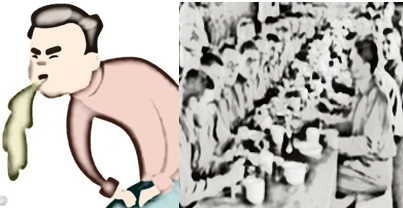It is a moral responsibility of the food provider in case people get sick due to eating unsafe food provided. It is an Occupational Illness (OI) if the food provided by the employer leads to sickness in the employees.
Food safety is important because unsafe food even now kills as per WHO estimate, about 4,20,000 every year globally and sickens around 600 million people despite the fact that more than 150 years ago, in 1862 President Abraham Lincoln had formed the USDA (United States Dept of Agriculture) and its Dept of Chemistry that eventually became FDA (Food and Drug Administration).
Human beings eat in large gatherings like workplace and functions (like marriages, conferences, seminars etc.), remote oilfields, aeroplanes etc. Each one of these places have hundreds of people and a ‘bad’ food can create havoc, chaos, hospitalizations, sickness absence, productivity losses, deaths, reputational issues etc.
In India, FSSAI (Food Safety and Standards Authority of India) was established on 5th September 2008 under Food Safety and Standards Act, 2006.
It is a moral responsibility of the food provider in case people get sick due to eating unsafe food provided. It is an Occupational Illness (OI) if the food provided by the employer leads to sickness in the employees.
Food poisoning has not spared anyone. It is said that Alexander the Great died of food poisoning, Mozart died of trichinosis (round worm infestation) and a US President Zachary Taylor died on 9th July 1850 of an ‘unknown digestive ailment’ potentially caused by eating raw fruit and drinking iced milk at a US Independence Day event on 4th July.
After the death of US President Zachary Taylor in 1850, it took America 12 years to form the FDA in 1862 under the Presidentship of Abraham Lincoln.
The Centers for Disease Control and Prevention (CDC) began keeping records on foodborne illnesses from 1970 onwards.
Removal of 75 million cans of mushrooms from stores in USA occurred in 1973 after a country-wide outbreak of botulism.
In 1975, one of the worst food poisoning incidents happened when almost 200 people onboard a Japan Air Lines flight got severely sick after eating airline food.
Again in 1975, Lancet, a medical journal reported a study when more than half the passengers onboard a 3rd February 1975, flight from Anchorage, Alaska, to Copenhagen, Denmark, suffered a gastrointestinal illness with symptoms of nausea, vomiting, abdominal cramps, and diarrhea.
Perhaps due to these two horrific incidents airline food safety became very stringent. In Mumbai I have seen a huge food facility that manufactures food for multiple airlines as also for Presidents and Prime Ministers.
I have had the experience of managing two food poisoning incidents in the oilfields of Oman involving around 70-80 people each time. Luckily, most had mild symptoms and only 2-3 employees had to be transferred to a hospital. But the thought of managing 70-80 people in a remote location can be daunting. The incidents happened despite having a stringent food and water safety program. The possible cause was inability to maintain the temperature of cold foods due to extreme outdoor temperature. In fact most investigations of food poisoning in airlines that keep happening is due to outdoor temperatures being high as most of such incidents happen when food is picked up by airlines in Asia or Africa.
Most cases of food poisoning occur due to bacterial contamination (Salmonella, Staphylococcus, Vibrio etc.) but history is rife with chemical contamination leading to food poisoning. However, chemicals also causes food poisoning.
Example: In 1955, in Morinaga Milk Industry in Japan, an industrial grade monosodium phosphate which contained an impurity of 5-8% arsenic, was added by mistake to milk produced by the company. Many babies were poisoned as the milk powder was used to feed them. More than 13,000 fell ill. By 1981 there were still more than 6000 people affected as adults with severe mental retardation and other health issues. And by 2006, more than 600 adults remained affected. A total of more than 600 people died due to this contamination.
Arsenic is a notorious chemical contaminant in foods. In the early 20th century, food poisoning was a major killer. England in 1900 witnessed the infamous English beer poisoning which affected more than 6000 people, leaving around 70 dead. Arsenic was introduced into the beer via contaminated sugar. The outbreak was made worse due to misdiagnosis of the illness.
A ‘bad’ food can create havoc, chaos, hospitalizations, sickness absence, productivity losses, deaths, reputational issues etc.
Someone said – if in doubt, throw it out! It is so true, else it can lead to untold miseries due to something that could have been prevented.
Details about food safety is not within the scope of this blog, but suffice to say that efforts must be taken to make sure food provided by the employer (if providing food to workers) and the food manufacturer follows some basics as below:
- Location: The surroundings of the place of food manufacturing facility must be clean. It cannot be next to a garbage collection area or an open gutter.
- Raw material: Procure raw materials to prepare food from a reputed vendor. Inspect the vendor periodically, even if reputed.
- HACCP (Hazard Analysis Critical Control Point): Ensure its implementation if food is procured externally
- Refrigeration:
- raw food
- cooked food
- veg food in upper trays, non-veg in lower trays
- Linear flow: In the kitchen it is about maintaining an order to cook a food item starting from storage, washing, cutting, mixing, cooking, cooling, packing and finally despatching.
- Food temperatures:
- Cold foods: store, transport and serve below 5 degrees C
- Hot foods: store, transport and serve around 65 degrees C
- Food-handlers
- Medical checks as per FSSAI recommendations (in India)
- Training
- Handwashing
- How to receive food
- Lifting techniques
- In house washing of utensils
- Attire should fit properly
- No use of jewellery
- Changing room: Industrial kitchen should have changing rooms for food-handlers to change before starting to prepare food
- Washroom: Should be away from food storage, cooking areas with soap and air hand dryer.
- Transportation of food: Use of insulated box keeps food dust-free and at requisite temperatures during transportation.
- MERP: In large corporations or remote locations have a Medical Emergency Response Plan (MERP) to manage food poisoning, if ever it occurs.
- Receiving cooked food from external contractor: Assign roles of responsibilities (Catering contractor, Employees, Admin, Health, Senior management etc.)
- Engage the catering contractor: Feedback
- Surprise inspections:
- Audits:
- Documentation: Ensure accurate and complete documentation of all activities connected with food safety
The above basic steps are indicative. They give the reader an idea about the various steps to consider to make food safe, in homes, at workplace and in food manufacturing facilities. Small offices or workplaces may provide a microwave oven and a refrigerator for use by employees to heat and store food brought from home.
A detailed understanding on prevention of food poisoning can be had by a food expert or by contacting the author.
To know more, contact
____________________________________________________________________________________________
Dr Ajay Sati is an Occupational Health physician who prefers to describe himself as an Occupationist, to denote, ‘an expert in diseases and other concerns of occupations.’ Dr Sati has managed health and wellness programs in industries he worked, like the atomic energy, and energy (oil & gas) in India and overseas. An experienced virtual consultation expert he was involved in many greenfield and brownfield projects providing inputs from health point of view.



